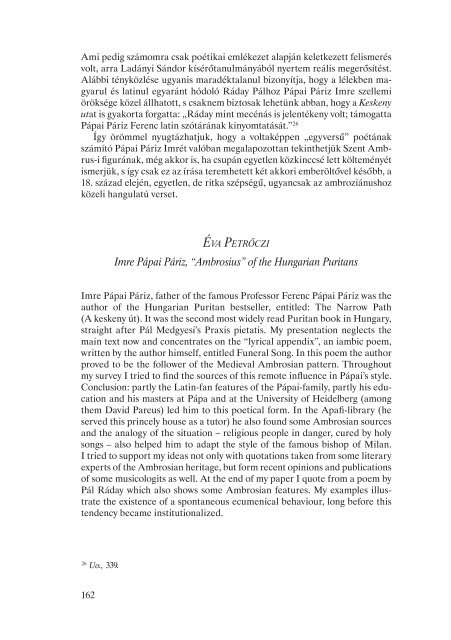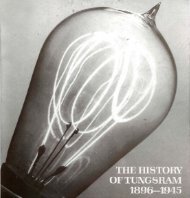Humanizmus, religio, identitástudat - MEK - Országos Széchényi ...
Humanizmus, religio, identitástudat - MEK - Országos Széchényi ...
Humanizmus, religio, identitástudat - MEK - Országos Széchényi ...
Create successful ePaper yourself
Turn your PDF publications into a flip-book with our unique Google optimized e-Paper software.
Ami pedig számomra csak poétikai emlékezet alapján keletkezett felismerés<br />
volt, arra Ladányi Sándor kísérőtanulmányából nyertem reális megerősítést.<br />
Alábbi tényközlése ugyanis maradéktalanul bizonyítja, hogy a lélekben magyarul<br />
és latinul egyaránt hódoló Ráday Pálhoz Pápai Páriz Imre szellemi<br />
öröksége közel állhatott, s csaknem biztosak lehetünk abban, hogy a Keskeny<br />
utat is gyakorta forgatta: „Ráday mint mecénás is jelentékeny volt; támogatta<br />
Pápai Páriz Ferenc latin szótárának kinyomtatását.” 26<br />
Így örömmel nyugtázhatjuk, hogy a voltaképpen „egyversű” poétának<br />
számító Pápai Páriz Imrét valóban megalapozottan tekinthetjük Szent Ambrus-i<br />
figurának, még akkor is, ha csupán egyetlen közkinccsé lett költeményét<br />
ismerjük, s így csak ez az írása teremhetett két akkori emberöltővel később, a<br />
18. század elején, egyetlen, de ritka szépségű, ugyancsak az ambroziánushoz<br />
közeli hangulatú verset.<br />
ÉVA PETRŐCZI<br />
Imre Pápai Páriz, “Ambrosius” of the Hungarian Puritans<br />
Imre Pápai Páriz, father of the famous Professor Ferenc Pápai Páriz was the<br />
author of the Hungarian Puritan bestseller, entitled: The Narrow Path<br />
(A keskeny út). It was the second most widely read Puritan book in Hungary,<br />
straight after Pál Medgyesi’s Praxis pietatis. My presentation neglects the<br />
main text now and concentrates on the “lyrical appendix”, an iambic poem,<br />
written by the author himself, entitled Funeral Song. In this poem the author<br />
proved to be the follower of the Medieval Ambrosian pattern. Throughout<br />
my survey I tried to find the sources of this remote influence in Pápai’s style.<br />
Conclusion: partly the Latin-fan features of the Pápai-family, partly his education<br />
and his masters at Pápa and at the University of Heidelberg (among<br />
them David Pareus) led him to this poetical form. In the Apafi-library (he<br />
served this princely house as a tutor) he also found some Ambrosian sources<br />
and the analogy of the situation – <strong>religio</strong>us people in danger, cured by holy<br />
songs – also helped him to adapt the style of the famous bishop of Milan.<br />
I tried to support my ideas not only with quotations taken from some literary<br />
experts of the Ambrosian heritage, but form recent opinions and publications<br />
of some musicologits as well. At the end of my paper I quote from a poem by<br />
Pál Ráday which also shows some Ambrosian features. My examples illustrate<br />
the existence of a spontaneous ecumenical behaviour, long before this<br />
tendency became institutionalized.<br />
26<br />
Uo., 339.<br />
162








![Letöltés egy fájlban [4.3 MB - PDF]](https://img.yumpu.com/50159926/1/180x260/letaltacs-egy-fajlban-43-mb-pdf.jpg?quality=85)








